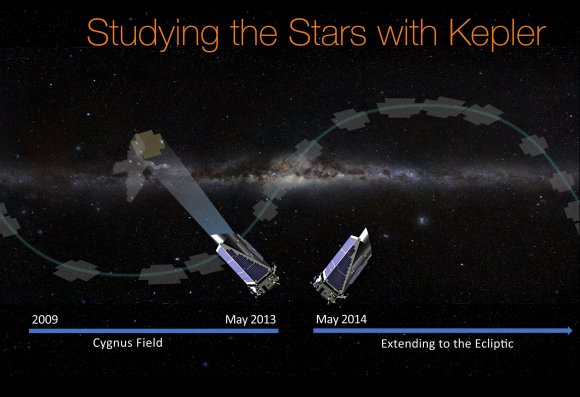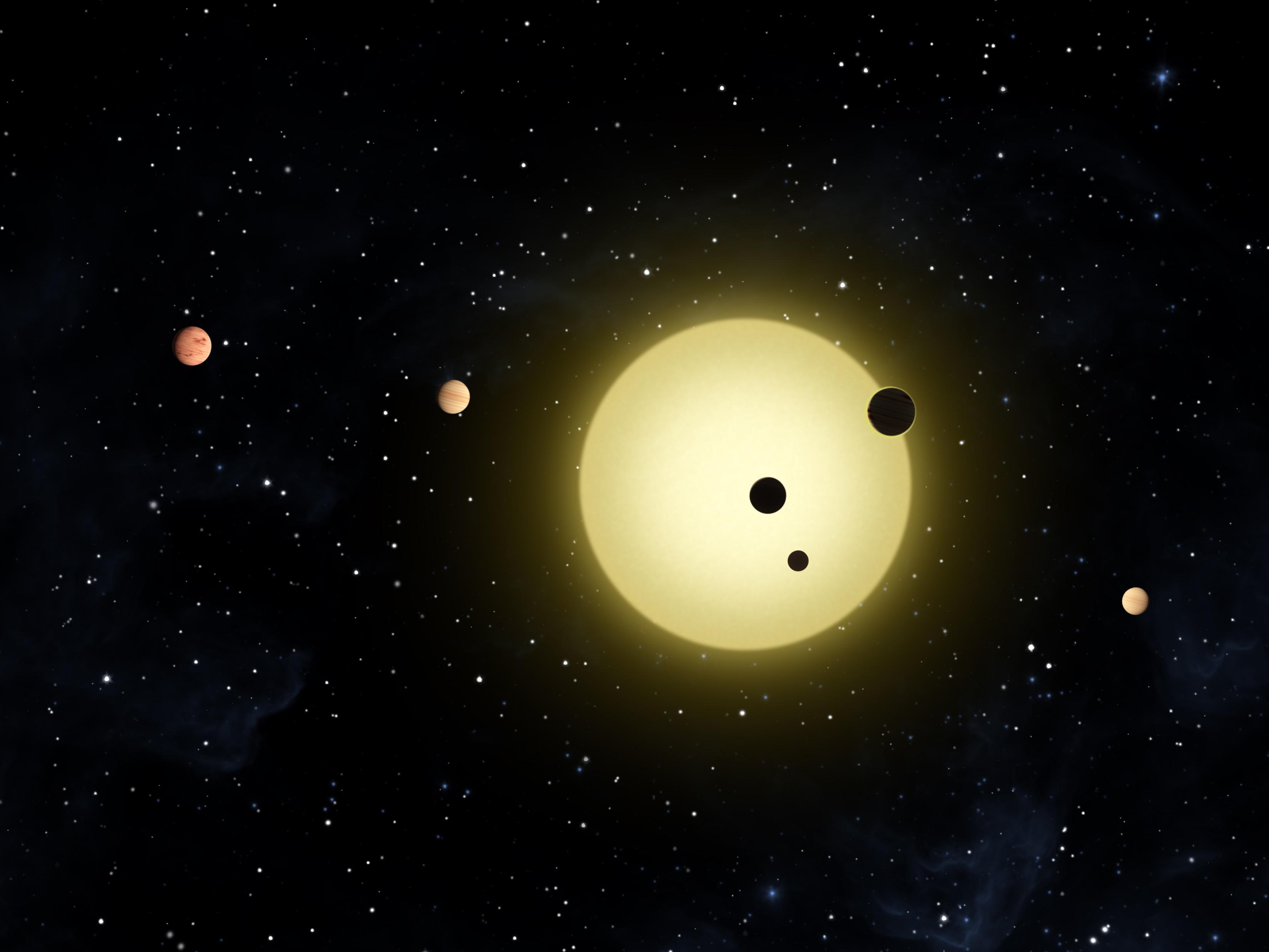With every passing year, more and more extra-solar planets are discovered. To make matters more interesting, improvements in methodology and technology are allowing for the discovery of more planets within individual systems. Consider the recent announcement of a seven-planet system around the red dwarf star known as TRAPPIST-1. At the time, this discovery established the record for most exoplanets orbiting a single star.
Well move over TRAPPIST-1! Thanks to the Kepler Space Telescope and machine learning, a team from Google AI and the Harvard-Smithsonian Center of Astrophysics (CfA) recently discovered an eighth planet in the distant star system of Kepler-90. Known as Kepler -90i, the discovery of this planet was made possible thanks to Google algorithms that detected evidence of a weak transit signal in the Kepler mission data.
The study which describes their findings, titled “Identifying Exoplanets with Deep Learning: A Five Planet Resonant Chain Around Kepler-80 and an Eight Planet Around Kepler-90“, recently appeared online and has been accepted for publication in The Astronomical Journal. The research team consisted of Christopher Shallue of Google AI and Andrew Vanderburg of the University of Texas and the CfA.

Kepler-90, a Sun-like star, is located roughly 2,545 light-years from Earth in the constellation Draco. As noted, previous surveys had indicated the existence of seven planets around the star, a combination of terrestrial (aka. rocky) planets and gas giants. But after using a Google algorithm created to search through Kepler data, the research team confirmed that the signal of a another closer-orbiting planet lurked within the data.
The Kepler mission relies on the Transit Method (aka. Transit Photometry) to discern the presence of planets around brighter stars. This consists of observing stars for periodic dips in brightness, which are an indication that a planet is passing in front of the star (i.e. transiting) relative to the observer. For the sake of their study, Shallue and Vanderburg trained a computer to read light-curves recorded by Kepler and determine the presence of transits.
This artificial “neural network” sifted through Kepler data and found weak transit signals that indicated the presence of a previously-missed planet around Kepler-90. This discovery not only indicated that this system is very much like our own, it also confirms the value of using artificial intelligence to mine archival data. While machine learning has been used to search Kepler data before, this research demonstrates that even the weakest signals can now be discerned.
As Paul Hertz, director of NASA’s Astrophysics Division in Washington, said in a recent NASA press release:
“Just as we expected, there are exciting discoveries lurking in our archived Kepler data, waiting for the right tool or technology to unearth them. This finding shows that our data will be a treasure trove available to innovative researchers for years to come.”
This newly-discovered planet, known as Kepler-90i, is a rocky planet that is comparable in size to Earth (1.32 ± 0.21 Earth radii) that orbits its star with a period of 14.4 days. Given its close proximity to its star, this planet is believed to experience extreme temperatures of 709 K (436 °C; 817 °F) – making it hotter than Mercury’s daytime high of 700 K (427 °C; 800 °F).
As a senior software engineer with Google’s research team Google AI, Shallue came up with the idea to apply a neural network to Kepler data after learning that astronomy (like other branches of science) is becoming rapidly a “big data” concern. As the technology for data collection becomes more advanced, scientists find themselves being inundated with data sets of ever-increasing size and complexity. As Shallue explained:
“In my spare time, I started googling for ‘finding exoplanets with large data sets’ and found out about the Kepler mission and the huge data set available. Machine learning really shines in situations where there is so much data that humans can’t search it for themselves.”
The Kepler mission, in its first four-years in operation, accumulated a dataset that consisted of 35,000 possible planetary transit signals. In the past, automated tests and sometimes visual inspections were used to verify the most promising signals in the data. However, the weakest signals were often missed with these methods, leaving dozens or even hundreds of planets unaccounted for.

Looking to improve on this, Shallue teamed up Andrew Vanderburgh – a National Science Foundation Graduate Research Fellow and NASA Sagan Fellow – to see if machine learning could mine the data and turn up more signals. The first step consisted of training a neural network to identify transiting exoplanets using a set of 15,000 previously-vetted signals from the Kepler exoplanet catalogue.
In the test set, the neural network correctly identified true planets and false positives with a 96% accuracy rate. Having demonstrated that it could recognize transit signals, the team then directed their neural network to search for weaker signals in 670 star systems that already had multiple known planets. These included Kepler-80, which had five previously-known planets, and Kepler-90, which had seven. As Vanderburg indicated:
“We got lots of false positives of planets, but also potentially more real planets. It’s like sifting through rocks to find jewels. If you have a finer sieve then you will catch more rocks but you might catch more jewels, as well.”
The sixth planet in Kepler-80 is known as Kepler-80g, an Earth-sized planet that is in a resonant chain with its five neighboring planets. This occurs when planets are locked by their mutual gravity into an extremely stable system, similar to what TRAPPIST-1’s seven planets experience. Kepler-90i, on the other hand, is an Earth-sized planet that experiences Mercury-like conditions and orbits outside of 90b and 90c.

In the future, Shallue and Vanderburg plan to apply their neural network to Kepler’s full archive of more than 150,000 stars. Within this massive data set, many more planets are likely to be lurking, and quote possibly within multi-planetary systems that have already been surveyed. In this respect, the Kepler mission (which has already been invaluable to exoplanet research) has shown that it has a lot more to offer.
As Jessie Dotson, Kepler’s project scientist at NASA’s Ames Research Center, put it:
“These results demonstrate the enduring value of Kepler’s mission. New ways of looking at the data – such as this early-stage research to apply machine learning algorithms – promises to continue to yield significant advances in our understanding of planetary systems around other stars. I’m sure there are more firsts in the data waiting for people to find them.”
Naturally, the fact that a Sun-like star is now known to have a system of eight planets (like our Solar System), there are those who wonder if this system could be a good bet for finding extra-terrestrial life. But before anyone get’s too excited, it is worth noting that Kepler-90s planets all orbit rather closely to the star. It’s outermost planet, Kepler-90h, orbits at a similar distance to its star as Earth does to the Sun.
The discovery of an eighth planet around another star also means there’s a system out there that rivals the Solar System in total number of planets. Maybe it’s time we reconsidered the 2006 IAU decision – you know, the one where Pluto was “demoted”? And while we’re at it, perhaps we should fast-track Ceres, Eris, Haumea, Makemake, Sedna and the rest for planethood. Otherwise, how else do we plan on maintaing our record?
In the future, similar machine learning processes are likely to be applied to next-generation exoplanet-hunting missions, like the Transiting Exoplanet Survey Satellite (TESS) and the James Webb Space Telescope (JWST). These missions are scheduled to launch in 2018 and 2019, respectively. And in the meantime, there are sure to be many more revelations coming from Kepler!


2540 years ago approx there will have been a FRB flash that illuminated Keppler 90 and Earth the flash will have been echoed from all the Keppler planetary bodies. With signal processing and the best dish antenna it may be possible to resolve the echo to learn something of the Keppler system.
Aren’t we being a bit hasty in designating everything that transits a distant star as a planet? Pluto was demoted because it didn’t comply with certain criteria, such as having swept it’s orbit clean of all debris. Has this or other restrictions been applied to extra solar planets? No. Cause we can’t determine any of those factors.
That’s just semantics. We find bodies orbiting other stars. What we call them (Planets, Meteoroids, Asteroids, Comets…etc.) doesn’t matter. Similar to contradicting someone who’s saying that a forest is full of trees by suggesting some are saplings and others, bushes. That’s a very odd and illogical nit to pick, actually.
So, we can’t edit any more… I reread your post and see I missed the point. Ya, we’ll narrow it down at some time, but for now, it is just a Semantic bookmark for later revision.
GOOGLE is SKYNET.
Although, not evil in this case.
If current definition of planet applies, they cannot tell there are 9 planets. There can be 9 planet-like objects.